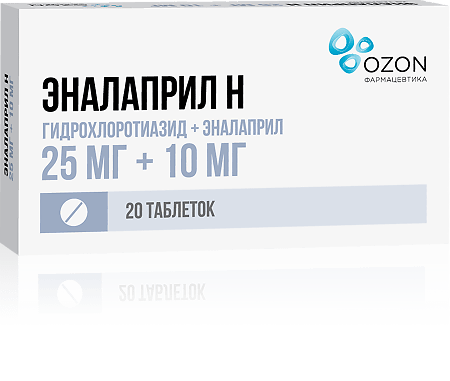No products in the cart.
Enalapril N, tablets 25 mg+10 mg 20 pcs
€6.49 €5.68
Description
Pharmgroup:
Hypertensive combined agent (ACE inhibitor+diuretic).
Pharmic action:
A combination drug whose action is due to its constituent components; has a hypotensive effect.
Hydrochlorothiazide is a medium-acting diuretic that increases urinary excretion of Na+, Cl-, water, hydrocarbonate. Reducing the concentration of Na+ in the vascular wall leads to their dilatation, reduces the sensitivity to vasoconstrictors.
Enalapril inhibits ACE, which promotes the conversion of angiotensin I into angiotensin II, reduces the concentration of aldosterone in the blood, increases the release of renin, improves the functioning of kallikrein-kinin vasodepressive system, stimulates the release of Pg and NO, suppresses the sympathetic nervous system. Taken together, these effects eliminate spasm and dilate peripheral arteries, reduce ROS, BP and BPD, post- and preload on the myocardium.
Hydrochlorothiazide reduces blood K+ concentration, enalapril causes its retention; when these drugs are used together, normal maintenance of blood K+ concentration is ensured.
Indications
Indications
Arterial hypertension.
Pharmacological effect
Pharmacological effect
Pharmaceutical group:
antihypertensive combination drug (ACE inhibitor + diuretic).
Pharmaceutical action:
A combined drug, the effect of which is determined by the components included in its composition; has a hypotensive effect.
Hydrochlorothiazide is a medium-strength diuretic that increases urinary excretion of Na+, Cl-, water, and bicarbonate. A decrease in Na+ concentration in the wall of blood vessels leads to their dilatation and reduces sensitivity to vasoconstrictor factors.
Enalapril inhibits ACE, which promotes the conversion of angiotensin I to angiotensin II, reduces the concentration of aldosterone in the blood, increases the release of renin, improves the functioning of the kallikrein-kinin vasodepressive system, stimulates the release of Pg and NO, and inhibits the sympathetic nervous system. Together, these effects eliminate spasm and dilate peripheral arteries, reduce peripheral vascular resistance, SBP and DBP, post- and preload on the myocardium.
Hydrochlorothiazide reduces the concentration of K+ in the blood, enalapril causes its retention; When these drugs are used together, normal maintenance of K+ concentration in the blood is ensured.
Special instructions
Special instructions
Therapy should be discontinued before testing parathyroid function. Subject to dialysis. Dose adjustments on days when dialysis is not performed should be based on blood pressure. Before and during treatment, monitoring of blood pressure, renal function, and plasma K+ concentration is necessary.
Caution must be exercised when prescribing to patients with reduced blood volume (as a result of diuretic therapy, limiting salt intake, hemodialysis, diarrhea and vomiting) due to the increased risk of sudden arterial hypotension after using even the initial dose. Transient arterial hypotension is not a contraindication for continuing treatment with the drug after stabilization of blood pressure. If severe arterial hypotension reoccurs, the dose should be reduced or the drug discontinued.
In case of excessive arterial hypotension, the patient is transferred to a horizontal position with a low head, and, if necessary, a 0.9% NaCl solution is administered (to increase plasma volume). Patients with decompensated CHF, ischemic heart disease and cerebral vascular diseases should be monitored, in whom a sharp decrease in blood pressure can lead to myocardial infarction or stroke, or impaired renal function.
The use of AN69 dialysis membranes in combination with ACE inhibitors is not recommended.
Active ingredient
Active ingredient
Hydrochlorothiazide, Enalapril
Composition
Composition
Hydrochlorothiazide + Enalapril: 25 mg + 10 mg.
excipients:
lactose monohydrate,
potato starch,
microcrystalline cellulose,
povidone,
sodium bicarbonate,
sodium carboxymethyl starch (sodium starch glycolate),
talc,
magnesium stearate.
Contraindications
Contraindications
Hypersensitivity (including to other sulfonamide derivatives), anuria, history of angioedema associated with taking ACE inhibitors, hereditary or idiopathic angioedema, pregnancy, lactation, childhood.
With caution. Renal/liver failure, severe systemic connective tissue diseases (including SLE, scleroderma), bilateral renal artery stenosis, stenosis of the artery of a single kidney, condition after kidney transplantation, aortic stenosis, CHF, ischemic heart disease, suppression of bone marrow hematopoiesis, cerebrovascular diseases (including cerebrovascular insufficiency), diabetes mellitus, hyperkalemia, diet with Na+ limitation, conditions accompanied by a decrease in blood volume (including diarrhea, vomiting), old age.
Side Effects
Side Effects
Most often: dizziness, increased fatigue.
1-2%: muscle cramps, nausea, asthenia, orthostatic hypotension, headache, cough, impotence.
From the cardiovascular system: fainting, decreased blood pressure, palpitations, tachycardia, chest pain.
Allergic reactions: angioedema (face, tongue, lips, vocal cords, larynx, extremities, intestines), malignant exudative erythema (Stevens-Johnson syndrome).
From the nervous system: dizziness, insomnia or drowsiness, paresthesia, increased excitability.
From the respiratory system: shortness of breath.
From the digestive system: dryness of the oral mucosa, dyspepsia (including nausea, vomiting, flatulence), diarrhea or constipation, abdominal pain, pancreatitis.
From the genitourinary system: impaired renal function, renal failure, decreased libido.
From the skin: skin rash, itching, sweating.
Laboratory indicators: hyperglycemia, hyper- or hypokalemia, increased urea concentration in blood serum, hypercreatininemia, hyperuricemia, increased activity of liver transaminases, hyperbilirubinemia, decreased Hb and hematocrit.
Other: gout, tinnitus, arthralgia, lupus-like syndrome (fever, serositis, vasculitis, myalgia/myositis, arthralgia/arthritis, positive test for antinuclear antibodies, increased ESR, eosinophilia, leukocytosis, skin rash, photosensitivity).
Overdose
Overdose
Symptoms: excessive decrease in blood pressure up to the development of collapse, myocardial infarction, acute cerebrovascular accident or thromboembolic complications; convulsions, stupor.
Treatment: gastric lavage, ingestion of saline solution, intravenous administration of plasma substitutes, angiotensin II, hemodialysis (excretion rate – 62 ml/min).
Manufacturer
Manufacturer
Ozon, Russia
Additional information
| Manufacturer | Ozon, Russia |
|---|---|
| Medication form | pills |
| Brand | Ozon |
Related products
Buy Enalapril N, tablets 25 mg+10 mg 20 pcs with delivery to USA, UK, Europe and over 120 other countries.
















